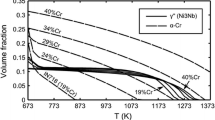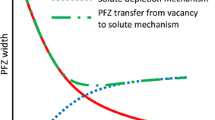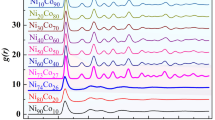Abstract
Differential thermal analysis (DTA) and microstructural and microprobe measurements of DTA and as-cast Ni-Re alloys with compositions between 0.20 and 0.44 mass fraction Re provide information to resolve differences in previously published Ni-Re phase diagrams. This investigation determines that the peritectic invariant between liquid, Re-rich hexagonal close packed and Ni-rich face center cubic phases, L + HCP → FCC, occurs at 1561.1 °C ± 3.4 °C (1σ) with compositions of liquid, FCC and HCP phases of 0.283 ± 0.036, 0.436 ± 0.026, and 0.828 ± 0.037 mass fraction Re, respectively. Analysis of the microsegregation in FCC alloys yields a partition coefficient for solidification, k = 1.54 ± 0.09 (mass frac./mass frac.). A small deviation from Scheil behavior due to dendrite tip kinetics is documented in as-cast samples. No evidence of an intermetallic phase is observed.














Similar content being viewed by others
Notes
Trade names are used for completeness and do not constitute an endorsement by NIST.
References
N. Saunders and A.P. Miodownik, CALPHAD (Calculation of phase diagrams): A comprehensive guide, Pergamon, Oxford, 1998.
S. B. Maisel, N. Schindzielorz, A. Mottura, R. C. Reed, and S. Müller, Physical Review B 2014 vol. 90, 094110.
R. P. Elliott, Constitution of Binary Alloys, First Supplement, McGraw-Hill 1965, pp. 666-667.
S.A. Pogodin and M.A. Skryabina: Sektora. Fiz. Khim., 1954, vol. 25, pp. 81-88.
T.B. Massalski: Binary Alloy Phase Diagrams, ASM International, Materials Park, 1990.
A. Nash and P. Nash: Bull. Alloy Phase Diagrams, 1985, vol.6, pp. 348-350.
H. Okamoto: J. Phase Equilibria, 1992, vol. 13, p. 335. Also H. Okamoto: J. Phase Equilibria Diffus., 2012, vol. 33, p. 346.
E. M. Savitskii, M. A. Tylkina, and E. P. Arskaya, Izv Vuz Tsvetn Met., 1970, vol. 4, pp.113-116.
C.M. Neubauer, D. Mari and D. C. Dunand: Scr. Metall. Mater., 1994, vol.31, pp. 99-104.
S. Narita: Master’s thesis, Graduate School of Hokkaido University, 2003.
S. Saito, T. Takashima, K. Miyama, K. Kurokawa and T. Narita, Materials Transactions, 2012,vol. 53, pp. 1078-1083.
W.J. Boettinger, M.E. Williams, K.-W. Moon, G.B. McFadden, P. N. Patrone and J. H. Perepezko, Journal of Phase Equilibria and Diffusion, 2017, vol. 38, pp. 750-763.
K. Yaqoob, J.-M. Joubert, Journal of Solid State Chemistry, 2012, vol. 196, pp. 320–325.
W. Huang and Y. A. Chang, Mater. Sci. Eng., 1999, vol. A259, pp. 110-119.
Automated Flow for Materials Discovery: http://www.aflowlib.org/. Accessed 6 Oct 2016.
Open Quantum Materials Database: http://oqmd.org/. Accessed 6 Oct 2016.
The Materials Project: https://www.materialsproject.org/. Accessed 6 Oct 2016.
H. W. Kerr & W. Kurz, International Materials Reviews, 1996, vol.41, pp. 129-164.
W.J. Boettinger, U.R. Kattner, K.-W. Moon, and J.H. Perepezko: NIST Special Publication 960-15. November 2006. https://www.nist.gov/publications/nist-recommended-practice-guides.
M. Hillert: Phase Equilibria, Phase Diagrams and Phase Transformations: Their Thermodynamic Basis, 2nd edn., 2008, Cambridge University Press, Cambridge, p. 244.
A T Dinsdale, CALPHAD, 1991, vol.15, pp. 317-425.
A.D. Pelton and W.T. Thompson: Prog. Solid State Chem., vol. 10(part 3), 1975, pp. 119-155.
C.E. Campbell: NIST, unpublished research, 2016.
W. J. Boettinger and J. A. Warren, Met. & Mat. Transactions A, 1996, vol. 27A, pp. 657-669.
W.J. Boettinger: J. Phase Equilibria Diffus., 2016, vol. 37, pp. 4–18. See also W.J. Boettinger, S.R. Coriell, and R.K. Trivedi: Rapid Solidification Processing: Principles and Technologies IV, R. Mehrabian and P. A. Parrish, eds., Claitor’s Publishing Division, Baton Rouge, LA, 1988, pp. 13–25.
S.C. Flood, J. D.Hunt, Appl. Sci. Res., 1987, vol. 44, pp 27-42.
Acknowledgments
William J. Boettinger acknowledges support from the U.S. Department of Commerce, National Institute of Standards and Technology, under financial assistance Award 70NANB15H279. The DTA measurements of K. Hildal and T. Sossaman, Department of Materials Science and Engineering, University of Wisconsin, the metallographic preparation of Sandra Claggett and the initial TEM work by Yaakov Idell, NIST, are greatly appreciated. Michael Katz is employed by the University of Maryland and is supported by NIST Grant 70NANB16H003.
Author information
Authors and Affiliations
Corresponding author
Additional information
Manuscript submitted July 19, 2018.
Appendices
Appendices
1.1 Appendix A: Scheil for Composition Dependent Partition Coefficient
The Scheil equation in differential form is
For CS = (k0 + k1CL)CL, integration by partial fractions gives
where CL = C0 for fS = 0 has been used. An expression for CS(fS) is obtained as
1.2 Appendix B: Histogram (Probability Density Plot) for Microsegregation
The data obtained from the pixel by pixel EDS measurement technique can be used to construct a probability density plot, P(CS)ΔCS, which is the fraction of pixels with composition between CS and CS + ΔCS. It is the probability that upon selecting a random location in the microstructure that the composition will lie between CS and CS + ΔCS. Such a plot (Figure B1) gives a more sensitive measure of the microsegregation than Figure 6(c).
For microsegregation following the Scheil expression for constant k,
or
P(CS) is given by \( - \frac{{df_{\text{S}} }}{{dC_{\text{S}} }}. \) Thus
Figure B1 shows the experiment probability plot for the Ni-20 pct Re as-cast materials and the corresponding Scheil histogram (C0 = 0.1816, k = 1.54). The deviation from the Scheil prediction is evident. A large fraction of the sample, ≈ 15 pct of the pixels, have a narrow range of composition between 27 pct Re and 29 pct Re. This peak corresponds to the dendrite stalk and arm cores formed during fast solidification. The minimum near 25 pct Re leads to the observed abrupt change in backscatter contrast in images of the FCC dendritic structures in as-cast samples.
1.3 Appendix C: Dendrite Tip and Truncated Scheil
In the Scheil approach, the transport of solute in the liquid phase is assumed to be sufficiently rapid that the liquid can be treated as being uniform in composition at each temperature during cooling. First solidification begins at the dendrite tip. The diffusion in the liquid in front of each dendrite tip leads to the fact that solidification starts slightly below the liquidus temperature and with composition different than kC0. Indeed the phase field method was used[24] to show the existence of relatively flat microsegregation profiles at the start of rapid dendritic solidification (See their Figure 12).
A simpler approach is given here. For a treatment of the kinetics of the dendrite tip in an alloy, the Ivantsov solution is obtained to determine the composition of solute at the dendrite tip. The marginal stability criterion is applied to determine the tip radius. The equations that govern the dendritic growth of binary alloy, C0, at velocity, V, and temperature gradient, G, are now summarized.[25] The composition of liquid at the dendrite tip, C *L , is given in terms of the Péclet Number, P = VR/2D; by
where R is the dendrite tip radius, k, is the partition coefficient, D is the liquid diffusion coefficient, and Iv(P) = Pexp(P)E1(P), where E1(P) is the first exponential integral. The tip radius is given by
where TMΓ is the capillary constant and mL is the liquidus slope. TM is pure material melting point and Γ is the ratio of the liquid-solid surface energy and the enthalpy of fusion per unit volume. The parameter ξ is a small correction for large P given by
The composition gradient in the liquid at the dendritic tip G *C is obtained from the Ivanstov diffusion solution as
The tip temperature is then given by
where mL is the liquid slope. For small temperature gradient, the dendrite tip temperature approaches the liquidus temperature as the dendrite tip velocity approaches zero. With increasing dendrite tip velocity, the dendrite tip temperature drops below the liquidus. Thus, first solidification occurs at a temperature below the liquidus.
The simplest approach to couple the dendrite tip analysis to the remainder of the solidification path is called the “Truncated Scheil” method originally proposed by Flood and Hunt[26] and modified to conserve solute by Boettinger.[25] First, the dendrite operating point (tip temperature and tip liquid composition neglecting curvature undercooling) is determined as described above. Second, a solute balance is performed using the liquid and solid compositions at the tip to determine the fraction of solid formed at the tip as
Third, a Scheil calculation is performed for the remainder of the solidification path. The calculation for this last step of the procedure would be started with “initial” values for the liquid compositions equal to the tip liquid composition and the fraction of solid equal to f tipS .
In summary,
Figure C1 shows three plots (a) dendrite tip solid composition vs dendrite tip velocity, (b) fraction solid at the tip vs velocity and (c) the microsegregation profile, solid composition vs fraction solid for the truncated Scheil model. Calculations are for the materials parameters in Table C1. Estimate of the solidification velocity is obtained using the expression, \( V = \ell \dot{T}/(L/C), \) where ℓ is a characteristic size of the casting (3 mm), \( \dot{T} \) is the estimated cooling rate (10 K/s) and (L/C) is the ratio of heat of fusion to the heat capacity of Ni (666 K). This estimate yields a velocity of ≈ 5 × 10−5 m/s, and gives a dendrite tip fraction solid of 0.11. This value roughly corresponds to the fraction solid width of the plateau seen at the start of the microsegregation profiles seen in Figure 6(c) and fraction solid width of the peak in Figure B1.
Three plots: (a) dendrite tip solid composition vs dendrite tip velocity, (b) fraction solid at the tip vs velocity and (c) the microsegregation profile, solid composition vs fraction solid for the truncated Scheil model for V = 5 × 10−5 m/s. The arc connects common values of the velocity on the two graphs. Note the flat composition profile in (c) at small values of fraction solid
Rights and permissions
About this article
Cite this article
Boettinger, W.J., Newbury, D.E., Ritchie, N.W.M. et al. Solidification of Ni-Re Peritectic Alloys. Metall Mater Trans A 50, 772–788 (2019). https://doi.org/10.1007/s11661-018-5019-z
Received:
Published:
Issue Date:
DOI: https://doi.org/10.1007/s11661-018-5019-z






